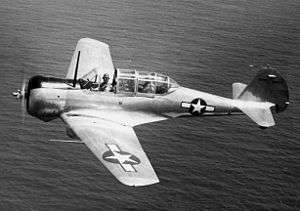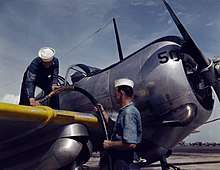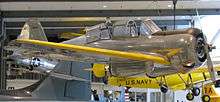Curtiss-Wright CW-22
The Curtiss-Wright CW-22 was a 1940s American general-purpose advanced training monoplane aircraft built by the Curtiss-Wright Corporation. It was operated by the United States Navy as a scout trainer with the designation SNC-1 Falcon.
| CW-22/SNC | |
|---|---|
 | |
| A U.S. Navy SNC-1 in September 1943 | |
| Role | Scout and advanced trainer |
| Manufacturer | Curtiss-Wright Corporation |
| First flight | 1940 |
| Introduction | 1942 |
| Primary users | United States Navy Royal Netherlands East Indies Army Air Force |
| Number built | 442 approx. |
Design and development
Developed at the Curtiss-Wright St. Louis factory, the CW-22 was developed from the CW-19 via the single-seat CW-21 light fighter-interceptor. The prototype first flew in 1940. With less power and performance than the CW-21, the two-seat, low-wing, all-metal CW-A22 had retractable tailwheel landing gear, with the main gear retracting rearward into underwing fairings.
The CW-22 was seen as either a civilian sport or training monoplane or suitable as a combat trainer, reconnaissance and general-purpose aircraft for military use. The prototype CW-A22 Falcon (U.S. civilian registration NC18067) was used as a company demonstrator and is one of four of the type still in existence. An SNC-1 is on display at the U.S. Navy's National Museum of Naval Aviation, at NAS Pensacola, Florida.
Operational history
The main customer for the aircraft equipped with the Wright R-975 Whirlwind air-cooled radial engine was the Royal Netherlands East Indies Army Air Force and 36 were exported. The aircraft had to be delivered to the Dutch in Australia due to the advancing Japanese forces. A developed version, the CW-22B, was sold to Turkey (50), the Netherlands East Indies (25) and in small numbers in South America. Some of the Dutch aircraft were captured and operated by the Imperial Japanese Army Air Force. The CW-22 and CW-22B were armed with two machine guns, one fixed.[1]
An unarmed advanced training version (CW-22N) was demonstrated to the United States Navy. To help to meet the expanding need for training, the Navy ordered 150 aircraft in November 1940. Further orders brought the total to 305 aircraft which were designated SNC-1 Falcon.[2]
Curtiss converted a CW-19 into a CW-22 demonstrator. They hoped to use this to sell the CW-22 to China. The aircraft was obtained by the Burma Volunteer Air Force, and later used by the Royal Air Force in India. It was scrapped in 1946. [3]
Variants



- CW-A22
- Prototype
- CW-22
- Production armed variant for the Royal Netherlands East Indies Army Air Force, 36 built.
- CW-22B
- Improved armed variant, approx 100 built.
- SNC-1 Falcon (CW-22N)
- United States Navy designation for the CW-22N, 305 built (BuNo 6290-6439, 05085-05234, 32987-32991).
Operators
- The Bolivian Air Force operated 10 aircraft.[4]
- Burma Volunteer Air Force [5]
- The Imperial Japanese Army Air Force operated captured ex-Dutch aircraft.
- The Royal Air Force in India operated the former Burma Volunteer Air Force aircraft
Survivors
- One surviving CW-22 is at Fantasy of Flight in Polk City, FL. It is on display in their "Golden Hill" storage facility awaiting its restoration to flying status.[6]
- Surviving CW-22R No. 15 located in Istanbul Aviation Museum.[7]
- Surviving SNC-1 located at the Uruguayan Aeronautical Museum, Air Force Base 1, Carrasco Int'l Airport, near Montevideo capital city.
Specifications (SNC-1)
Data from Curtiss Aircraft 1907–1947[8], The encyclopedia of world aircraft[9]
General characteristics
- Crew: 2
- Length: 27 ft 0 in (8.23 m)
- Wingspan: 35 ft 0 in (10.67 m)
- Height: 9 ft 11 in (3.02 m)
- Wing area: 173.7 sq ft (16.14 m2)
- Airfoil: Curtiss CW-19 Special[10]
- Empty weight: 2,736 lb (1,241 kg)
- Gross weight: 3,788 lb (1,718 kg)
- Powerplant: 1 × Wright R-975-28 Whirlwind 9-cylinder air-cooled radial piston engine, 450 hp (340 kW) for take-off ; 420 hp (310 kW) max continuous
- Propellers: 2-bladed variable-pitch metal propeller
Performance
- Maximum speed: 198 mph (319 km/h, 172 kn) at sea level
- Range: 780 mi (1,260 km, 680 nmi)
- Service ceiling: 21,800 ft (6,600 m)
- Rate of climb: 1,650 ft/min (8.4 m/s)
Armament
- Guns: 1x fixed forward-firing synchronised 0.300 in (7.6 mm) machine-gun and 1x flexibly mounted 0.300 in (7.6 mm) machine-gun in the rear cockpit
References
Notes
- Andrade 1979, p. 171.
- Bowers 1990, p. 484.
- Aeromilitaria No.1/1991 (Air Britain)
- http://www.aeroflight.co.uk/waf/americas/bolivia/Bolivia-af-CW22.htm
- http://www.aeroflight.co.uk/waf/aa-eastasia/burma/burma-bvaf-aircraft.htm#cw22
- Fantasy of Flight Facebook Page, March 18, 2013.
- http://www.aviationmuseum.eu/World/Europe/Turkey/Istanbul/Yesilkoymuseum.htm
- Bowers, Peter M. (1979). Curtiss aircraft, 1907-1947. London: Putnam. pp. 463–465. ISBN 0370100298.
- Donald, David (31 December 1997). The encyclopedia of world aircraft (Updated ed.). Blitz Editions. p. 296. ISBN 978-1856053754.
- Lednicer, David. "The Incomplete Guide to Airfoil Usage". m-selig.ae.illinois.edu. Retrieved 16 April 2019.
Bibliography
- Andrade, John. U.S. Military Aircraft Designations and Serials since 1909. Hinckley, UK: Midland Counties Publications, 1979. ISBN 0-904597-22-9.
- Bowers, Peter M. Curtiss Aircraft 1907–1947. London: Putnam, 1979. ISBN 0-370-10029-8.
- Bowers, Peter M. United States Navy Aircraft since 1911. Annapolis, Maryland: Naval Institute Press, 1990. ISBN 0-87021-792-5.
- Donald, David, ed. The Encyclopedia of World Aircraft. Etobicoke, Ontario: Prospero Books, 1997 ISBN 1-85605-375-X.
- The Illustrated Encyclopedia of Aircraft (Part Work 1982–1985). London: Orbis Publishing, 1985.
External links
| Wikimedia Commons has media related to Curtiss-Wright CW-22. |